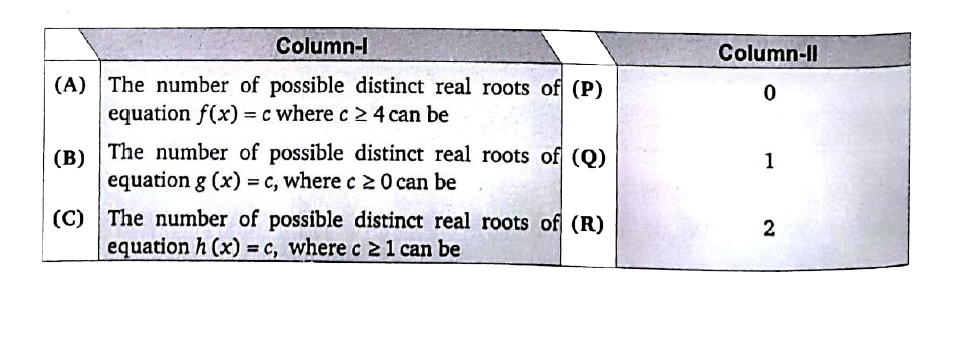If (f(x)−1)(x2+x+1)2−(f(x)+1)(x4+x2+1)=0
∀x∈R−{0}andf(x)≠±1, then which of the following statement (s) is/are correct ?
∣f(x)≥2∀x∈R−{0}
f(x) has a local maximum at x=−1
f(x) has a local minimum at x=1
∫π−π(cosx)f(x)dx=0
The correct Answer is:A, B, C, D
To solve the equation given by:
(f(x)−1)(x2+x+1)2−(f(x)+1)(x4+x2+1)=0
we will simplify and analyze the equation step-by-step.
Step 1: Rearranging the Equation
We start by rearranging the equation:
(f(x)−1)(x2+x+1)2=(f(x)+1)(x4+x2+1)
Step 2: Dividing Both Sides
Next, we can divide both sides by (f(x)+1)(f(x)−1) (since f(x)≠±1):
(f(x)−1)(x2+x+1)2(f(x)+1)(f(x)−1)=(f(x)+1)(x4+x2+1)(f(x)+1)(f(x)−1)
This simplifies to:
(x2+x+1)2x4+x2+1=f(x)−1f(x)+1
Step 3: Cross Multiplying
Cross-multiplying gives us:
(f(x)−1)(x4+x2+1)=(f(x)+1)(x2+x+1)2
Step 4: Expanding Both Sides
Now we expand both sides:
Left-hand side:
f(x)x4+f(x)x2+f(x)−x4−x2−1
Right-hand side:
f(x)(x4+2x3+3x2+2x+1)+(x2+x+1)2
Step 5: Collecting Like Terms
After expanding, we can collect like terms and simplify the equation to find f(x).
Step 6: Finding Critical Points
To find local maxima and minima, we differentiate f(x) and set the derivative equal to zero.
Step 7: Analyzing the Function
We analyze the critical points to determine the nature (maxima or minima) of the function f(x).
Step 8: Conclusion
From the analysis, we conclude the following statements about f(x):
1. The maximum value of f(x) is 2.
2. The minimum value of f(x) is -2.
3. The function has local maxima and minima at specific points.
We start by rearranging the equation:
Next, we can divide both sides by (f(x)+1)(f(x)−1) (since f(x)≠±1):
Cross-multiplying gives us:
Now we expand both sides:
f(x)x4+f(x)x2+f(x)−x4−x2−1
f(x)(x4+2x3+3x2+2x+1)+(x2+x+1)2
After expanding, we can collect like terms and simplify the equation to find f(x).
To find local maxima and minima, we differentiate f(x) and set the derivative equal to zero.
We analyze the critical points to determine the nature (maxima or minima) of the function f(x).
From the analysis, we conclude the following statements about f(x):
1. The maximum value of f(x) is 2.
2. The minimum value of f(x) is -2.
3. The function has local maxima and minima at specific points.
Topper's Solved these Questions
- APPLICATION OF DERIVATIVES BOOK - VIKAS GUPTA (BLACK BOOK) ENGLISHCHAPTER - APPLICATION OF DERIVATIVES EXERCISE - EXERCISE (COMPREHENSION TYPE PROBLEMS)
15 Videos
- APPLICATION OF DERIVATIVES BOOK - VIKAS GUPTA (BLACK BOOK) ENGLISHCHAPTER - APPLICATION OF DERIVATIVES EXERCISE - EXERCISE (MATHCING TYPE PROBLEMS)
6 Videos
- APPLICATION OF DERIVATIVES BOOK - VIKAS GUPTA (BLACK BOOK) ENGLISHCHAPTER - APPLICATION OF DERIVATIVES EXERCISE - EXERCISE (SUBJECTIVE TYPE PROBLEMS)
22 Videos
- AREA UNDER CURVESBOOK - VIKAS GUPTA (BLACK BOOK) ENGLISHCHAPTER - AREA UNDER CURVESEXERCISE - AXERCISE (SUBJECTIVE TYPE PROBLEMS)
8 Videos
Similar Questions
If f''(x)∣≤1∀x∈R,andf(0)=0=f'(0), then which of the following can not be true ?
View SolutionLet f(x)=⎡⎢⎣x(3e1/x+4)2−e1/x(x≠0)0x=0x≠1ln2 which of the following statement (s) is/are correct ?
View SolutionIf f(x)={x−ex+1−(1−cos2x)x2x≠0kx=0 is continous at x=0 then which of the following statement is false ?
View SolutionLet f:I−{−1,0,1}→[−π,π] be defined as f(x)=2tan−1x−tan−1(2x1−x2), then which of the following statements (s) is (are) correct ?
View SolutionIf f(x)+2f(1−x)=x2+2∀x∈Randf(x) is a differentiable function, then the value of f'(8) is
View SolutionIf g(x)=x2−1andgof(x)=x2+4x+3, then f(12) is equal (f(x)>0∀x∈R)
View SolutionIf g(x)=x2−1 and gof (x)=x2+4x+3 , then f(12) is equal (f(x)>0∀x∈R) :
View SolutionIf f(x)=x−1x,x≠0 then f(x2) equals.
View SolutionLet f(x)=x3−4(x−1)3∀x≠1,g(x)==x4−2x24∀x∈R,h(x)x3+4(x+1)3∀x≠−1,


View SolutionIf f(x)+2f(1−x)=x2+2∀x∈R, then f(x) given as
View Solution
